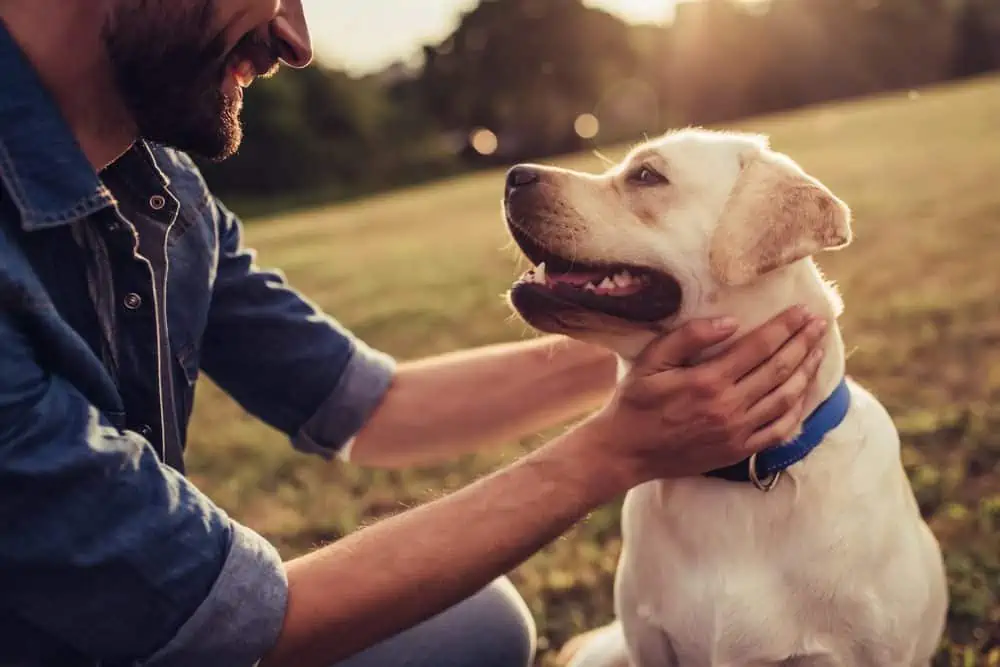
Is talking to your dog the first sign of madness? In fact, not talking to your dog is the first sign that you’re not making the most of the incredible human/canine relationship. Research over the last couple of decades reveals that dogs can understand human communication in ways no other species can. Living in close contact with humans for over 30,000 years has enabled canines to evolve communication skills that some experts believe are effectively equal to those of human children.
Yet, a survey by Dogs Trust, the UK’s largest dog welfare charity, shows that only 1 in 5 dog owners think that playing and bonding with their dog includes actually chatting with them.
Dogs Trust’s senior behaviour and training advisor, Alasdair Bunyan, believes that this is all wrong: “Intermittently talking with your dog is an important and easy way to strengthen your bond of trust and friendship. Over half of dog owners we asked, 57%, claimed that it’s lack of time which prevents them from playing with their dog, yet I’d say intermittently talking to your dog is something you can so easily do while you’re doing other things – like cooking or watching TV!”
Do you ever talk to your dog?
42% of owners say they do not speak with their dog when walking him
13% of owners say they talk on their mobile phone instead of interacting with their pet
Source: Dogs Trust
Eye-to-eye contact
As well as strengthening the unique human/canine bond, Dogs Trust stresses that regular chats with your canine chum can also make a huge difference when it comes to training. “Forming a trusting bond by building a two-way communication system with your dog will make the next steps in your training journey so much easier. You’d never send a kindergarten child off to secondary school, yet that’s exactly what we are doing with our dogs when we begin their training with ‘sit, ‘stay’ ‘come back.’ That’s A-level stuff; we need to concentrate on building up our relationship first by understanding our dog’s needs, having a two-way communication system and simply having fun together, and that includes eye contact while chatting to your dog.”
Empty relationship
And, as for those who prefer to check their phone messages rather than engage with their pet on walks, Alasdair bemoans: “To me, there is nothing sadder than seeing a person glued to their mobile while walking their dog – it looks like an empty relationship. Your dog walks are the perfect opportunity for you to really communicate with each other, using play, which can be simple tug games or more complex interactions such as search games.’
The reality is that dogs are super keen to communicate with humans – after all, they’ve had thousands of years to build up their skills. What’s more, experts believe the most successful communication is a mix of speech and gestures.
Who are the chattiest dog owners?
When asked if they talk to their dog, respondents stated:
Yes, all the time: female 82%, male 65%
Occasionally: female 16%, male 31%
Never: female 2%, male 4%
Source: Dogs Trust
Every word you say, every move you make
Juliane Kaminski , Senior lecturer in psychology, University of Portsmouth, says: “It’s also been proven that we can communicate with dogs through physical gestures. From puppy age on, dogs respond to human gestures, such as pointing, in ways other species cannot. This is fascinating because not even human’s closest living relatives, chimpanzees, seem to understand that humans communicate intent in this situation. Nor do wolves – dog’s closest living relatives – even if they are raised like dogs in a human environment.
“Dogs have been used for thousands of years to help with herding and hunting, when they had to be guided over a great distance by gestural instructions. The latest research affirms the idea that not only have dogs developed an ability to recognise gestures but also a special sensitivity to the human voice that helps them identify when they need to respond to what’s being said.”
So, if you don’t regularly chat to your dog, it’s time to start now – and add in some hand gestures for good measure. Remember that your dog is constantly studying you and wanting to respond. One day, they may even be able to answer back...
Sources: Dogstrust.org.uk, theconversation.com














